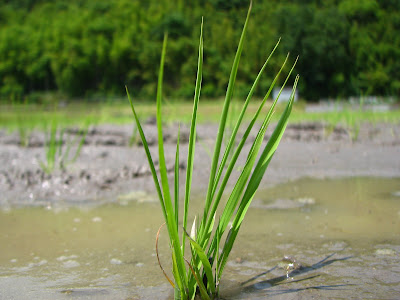The rainy season officially started in Japan about a week ago. With the barrage of often unrelenting rains that begin in early summer and last for about a month or so, come seasonal rice paddies in Wakayama, Japan.
Japan 's topography is that of mountains. When heavy rains fall on mountains, rivers and pools form and harbor the vast quantity of water. The volume of water is such though, that even with all the ponds and brooks atop mountains, gravity forces huge portions of water down into valleys. Valleys in Japan are the places where people live and dwell. In these erratically dispersed flat lands, rainwater flows into bigger rivers and larger water vessels, eventually converging with the sea. However, long before reaching the sea much of this water is directed into fields called tanbo in Japanese. The tanbo or paddies as we know them in the west, are flat areas around the perimeters of which are borders of concrete, metal, or plastic. These relatively low borders of only about a foot (30cm) or so, act as containment walls for keeping water in the desired fields.
Since there is no lack of water during the rainy season, a constant supply is always on hand to keep the tanbo full. It is essential that water fill paddies as the varieties of rice grown in Asia are semi-aquatic, and depend on partial submergence to sustain their very existence.

It all begins at the top.

Tiny brooks like these form on mountain sides.

The brooks flow into one another and become larger streams.

There are often natural or man-made ponds like the one above that are partially fed by these streams. Most of these ponds called tameike remain present all year round as they are true ponds primarily fed by permanent water sources such as underground springs.

The tameike or rice paddy ponds, create habitats for many forms of plant and animal life. These ponds are often home to water lilies, duckweed, dragonflies carp, shrimp, newts, frogs, and turtles. Although not entirely reliant on them, many other creatures also frequent the ponds. Birds including kingfishers, egrets, herons, and ducks can commonly be found in and around the tameike. Snakes, wild boars, deer and other forest denizens also make their rounds at rice paddy ponds. Above are two Red-Eared Slider Turtles (Mishishipi Akamimigame), a species introduced into the wilds of Japan many years ago. Initially they were brought here as pets, and after being released into natural ponds and rivers subsequently became part of the ecosystem.
I took the above picture at a pond just on the side of my in-law's home. To the pond, it's just a two minute walk through a dense forest of tall bamboo from our house.
I dubbed the pond "Sangame Ike" (Three Turtle Pond) upon identifying three species of turtles inhabiting it.
Water from the streams and ponds run down mountain sides.
The water is then channelled into an elaborate network of open water ducts commonly seen along neighborhood streets, as well as larger roads.

The canals empty out into tanbo which are located haphazardly throughout neighborhoods in more suburban areas. In the town where Atsuko and I live (Otani), there are rice paddies of varying sizes which range from small to large. Otani like the hundreds of other Japanese towns resembling it, becomes a wetland oasis during the rainy season. It's a marvelous thing to experience. Otherwise "normal" neighborhoods are transformed literally overnight, into marshlands.
This tanbo has been filled and is ready for planting
Here we see trays of rice seedlings which sit on the edge of a tanbo waiting to be transplanted.
A rice seedling stands firm in it's new muddy home
Tractors and other automated machinery aid farmers during the rice season.

For small-scale farmers like the ones in our neighborhood, smaller equipment is sufficient to get the task done.
Of course there is no substitute for the human hand! Here Kento Ikeura, 6 years old, of Kanaike town helps out in the family rice paddy.
The tanbo often envelop a neighborhood to a degree that houses become "island sanctuaries" for those who live in them.

On clear days, blue skies are reflected in them. Particularly spectacular are fluffy white cloud reflections in a tanbo. Above, an onion-drying shack sheds it's reflection down across the glassy surface.

Like ponds and rivers that feed them, the tanbo become seasonal aquatic nurseries, feeding and drinking grounds, and play areas for a multitude of living creatures. One such inhabitant is the small (usually almond-sized) Rice Frog or Numagaeru. In the photograph above a Rice Frog floats in a recently filled tanbo
 It all begins at the top.
It all begins at the top. Tiny brooks like these form on mountain sides.
Tiny brooks like these form on mountain sides. The brooks flow into one another and become larger streams.
The brooks flow into one another and become larger streams.












 On clear days, blue skies are reflected in them. Particularly spectacular are fluffy white cloud reflections in a tanbo. Above, an onion-drying shack sheds it's reflection down across the glassy surface.
On clear days, blue skies are reflected in them. Particularly spectacular are fluffy white cloud reflections in a tanbo. Above, an onion-drying shack sheds it's reflection down across the glassy surface.
No comments:
Post a Comment